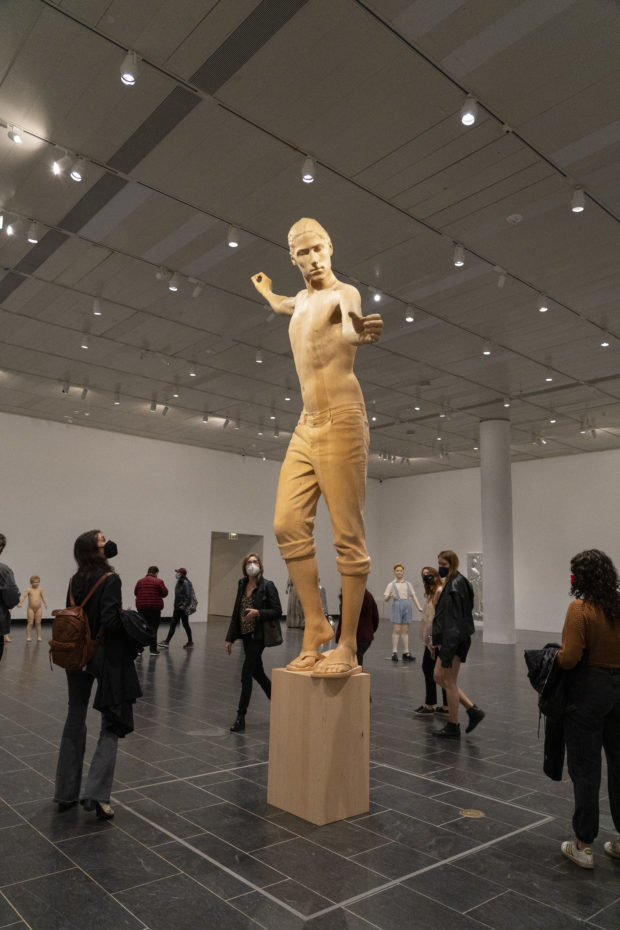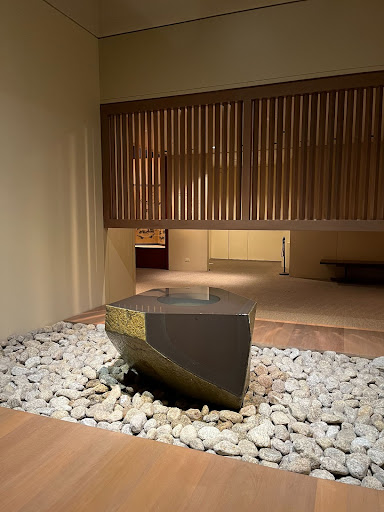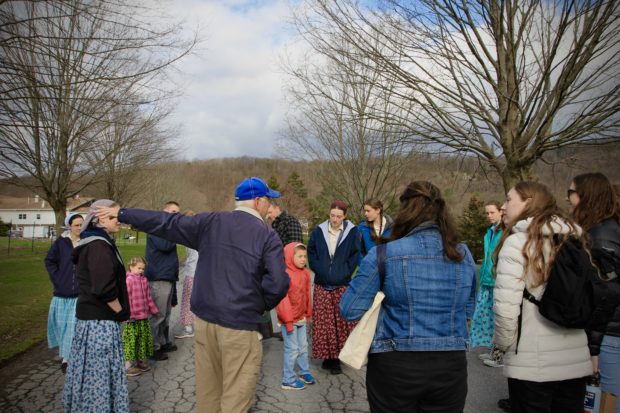Religious Art at the Met
This year's Covering Religion class took a tour of religious art at the Metropolitan Museum of Art. Led by Amy Herman from The Art of Perception training seminar, our students got to not only see significant religious pieces, but better understand how to analyze them from the lens of an art historian. Here is a roundup of what some students learned from the field trip.
Motif of the Angel Gabriel

From Richa Karmarkar–
The Archangel Gabriel is found in the Old Testament, the New Testament and the Quran–and in many of the Met’s religious art pieces, if you know where to look. As a herald and messenger of God, Gabriel is often shown in proximity to Mary, giving her the news that she will give birth to Jesus. The Annunciation, as it is referred to by Christians, has been depicted in paintings dating all the way back to the 4th century. As our guide told us, there are certain motifs that appear in Annunciation paintings–especially the dove, or the symbol of the Holy Spirit.
The Holy Spirit indicates God’s ineffability and activeness in the material world as much as the spiritual. The dove, often shown flying down through a ray of light, can also represent the message being flown to Mary–that she will bear the “son of the most high.”

A larger than life-sized man made out of wood stands before the class in a striking pose, yet unmistakably in motion. The statue is overwhelming in stature, but carved with the utmost care and detail. The art piece is called Archangel by Charles Ray, and it depicts a surfer-like, blue-collar, modern version of Gabriel himself.
The Archangel statue is facing towards the ground with an expression that mirrors other paintings of Gabriel; he is wise and knowing, and he is flying down with outstretched arms, or wings, to deliver his message. I found it especially intriguing to compare this piece with the other renditions of Gabriel and Mary. There is always movement found in this type of religious art, but this statue in particular seemed to engulf the audience as part of the story.
The Meditative Art of Buddhism and Shinto
There is a distinct calmness to be felt in the East Asian section of the Metropolitan Museum of Art. Colors of the sea and Buddhist and Shinto motifs flow through the walls and decor as if to mimic the tranquility of the belief system itself.
In contrast to the early European paintings depicting Jesus’s life, the sculptures in this section are subtle in their appearance and color scheme. The materials used are earthly–stone, wood and water. Throughout our time at the museum, I found myself reminiscing about the meditative qualities of the Buddhist and Shinto art. I was able to think more clearly when I looked at them, perhaps a connection to the contemplative nature of both religions.

A Buddha sculpture hangs from the ceiling, created solely out of wire and rattan, a reed-like wood made from palm stems. Without a face, the Buddha is striking, but not intimidating. His body does not touch the floor; instead, his torso morphs into long curls of material. The transparency of the statue reminds me of the oneness with surroundings that I've learned Buddhists strive for.

A deer stands frozen in the middle of another room, covered in glass spheres of various sizes. I am surprised to hear from our guide that we are looking at a real, taxidermied deer. The light reflects off of the deer’s new, crystallized form, offering a peaceful end to the deer’s life on earth. I enjoy the artist’s juxtaposition of life and death, as well as light and dark, as it allows me to see what the deer once was, as well as what it is in the Shinto religion–a sacred messenger of the Gods.

From Catherine Zhang–
Adjacent to the serene beauty of Buddhist and Shinto art is a figure that looks like it was designed to inspire fear rather than inner peace.
Emaciated and gaunt, Chamunda the Horrific Destroyer of Evil wears the look of a corpse in the statue dedicated to her.
The sandstone she is carved from is pitted and worn down with the age of 10 centuries, adding to her fearsome appearance. Her 8 shoulders are absent their forearms, her legs absent shins. Whether they were lost to time or in a cosmic battle is a secret she keeps behind bared teeth.
Despite her wicked and decayed look, Chamunda still carries a regal appearance, with a tall crown on her brow and decorated cuisses armoring her thighs. She holds herself confidently with shoulders squared and head high. She is confrontational and prepared, and seems to dredge up the same feelings within those who look at her.

During our trip to the MET, we saw the Japanese Shinto religious art piece that caught everyone’s eyes. It is a black stone with water flowing quietly over it. The piece shows the perfect balance of quiescence and dynamic between the stone and water, but also between the sound of the water flowing and the stillness of its entity. The simplicity and balance in this piece represent the core concepts in Japanese religion and culture. What’s more, ”purity“ is one of the key ideas in Shinto. At a Shinto temple, rituals begin with a process of purification, often involving the washing of the hands and mouth at the temizu basin in the garden of a temple. Therefore, I think the piece also represents this ritual in Shinto, showing the place people purify themselves, and maybe also the purpose (to reach the perfect balance between quiescence and dynamic of one’s body) of purifying before they enter the temple to pray.
As Ukrainian Refugees Arrive, Hungary Remembers its History
BUDAPEST-- On a cold spring day, before the trees began to bud, Hungarian journalist Kinga Rajvak invites us into her apartment in the old Jewish Quarter of Budapest. The building stands tall, its bright green door contrasting the light gray of the early morning sky.
Right across from her wood dining room table sits a palm plant basking in the sun. It hides a discolored brick window frame. Rajvak said, “this dent right here was from a Russian bomb, during the 1954 uprising.”
The combination between past and present haunts Hungary. Talking about current events tends to lead into a comparison of a similar event from one of the country’s many dark chapters of its long history.
Hungary made headlines for its exclusionary and anti-Muslim refugee laws during the 2015 Syrian refugee crisis. Today, Ukrainian refugees receive very different treatment, though the laws remain the same. The common factor in these crises is Prime Minister Viktor Orbán.
On April 3, Orbán won his fourth consecutive term as prime minister, according to election results. Much of his party’s platform consists of anti-LGBTQ rhetoric and far-right ideals that are similar to legislation currently introduced and passed in Texas and Florida. Orbán describes his governing style as “illiberal democracy,” and is critical of Western values. He is an ally of Russian President Vladimir Putin, taking a pro-Russian stance on the war in Ukraine.
This relationship ratcheted up recent tensions in Budapest. Religious non-profits including Caritas, the Jewish Community Center (JCC) and the Jewish Joint Distribution Committee all helped refugees when Orbán’s government would not. As the April election drew nearer, the relief efforts were folded into a joint charity council that now has complete government oversight.
Many religious leaders involved in Ukrainian relief efforts are furious about Putin’s war and Orbán’s support for it. However, they must hold their tongue out of fear of government retaliation. They fear that they will lose whatever government backing that they get for the relief efforts.
The political split with the government, however, does not inhibit the work of the religious nonprofits, such as the JCC Budapest, according to the agency’s director, Marcel Kenesei. Instead, he said that the JCC focuses on its humanitarian efforts rather than on Orbán's agenda. Kenesei said the majority of the Ukrainian refugees that his agency has helped decided not to stay in Hungary long-term but instead emigrate to Israel.
“A lot of the people who live in Ukraine and belong to the Jewish community, and decide to leave the country, they are going to end up in Israel because a lot of the Jews have either Israeli citizenship or they are eligible to apply,” Kenesei said. “To get Israeli citizenship, that was an obvious choice for a lot of people.”
For Lyubov and her 4 year-old daughter, Daniel, who withheld their surnames for privacy, the ultimate goal is to get to Israel, she said sitting in the main room of the JCC, as her daughter drew in the seat next to her.
“So like all the people who came here, we need to spend some time here, then go to Israel because we are Jewish,” Lyubov said. “It takes somebody two weeks, maybe three weeks to make these documents.”
Lyubov and Daniel have no documents with them other than their passports. They fled Bucha just days before an alleged massacre was revealed to the world through drone footage obtained by the British government. Since Lyubov did not have documentation, they could only travel by train or bus. At first, she said she took Daniel to a border town in Poland. Once they arrived, she said she immediately left for Hungary because there were too many Ukrainians and not enough resources for her daughter and her. But, Budapest was never going to be a final destination for them.
“As far as I know, Viktor Orbán, the Prime Minister of Hungary, is more loyal to Russians than other prime ministers of other countries, and I don’t know which political view there will be in Hungary with him in power,” she said. “So, I would like to move to the place where we know for sure they defend us and want to stay on our side.”
Lyubov looked down at Daniel who was fussing with her red glasses and rubbing her eyes. As she was climbing into her mother’s lap, she gave Lyubov her stuffed rabbit to hold for her. Lyubov looked into the animal's black beaded eyes and said, “our bunny is with us.”
Palm Sunday on a Christian Commune
ULSTER PARK, N.Y. -- Founded in 1920’s Germany, the Bruderhof (translated to “place of brothers”) is an Anabaptist Christian movement. Among other faith principles, the Bruderhof movement emphasizes pacifism, common ownership, adult baptism and evangelism. The Bruderhof has 26 settlements all over the world - 17 of which are in the United States - and all are organized around the customs in a book written and published by members of the community, Foundations of Our Faith and Calling.
On Palm Sunday, our class's reporters spent the holiday among one of the Bruderhof’s larger settlements, listening to their members' stories and seeking to break down barriers and understand this century-old religious crusade.
Scroll through the photos below for a glimpse of the day.








All photos by Riley Farrell, April 22.



